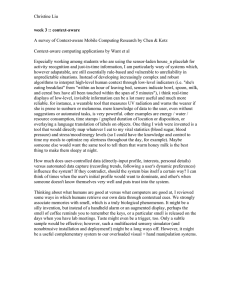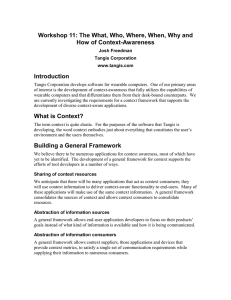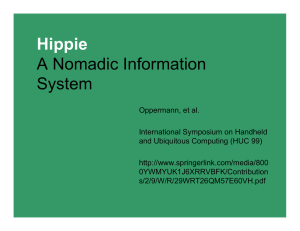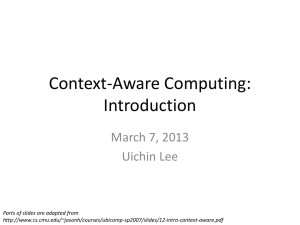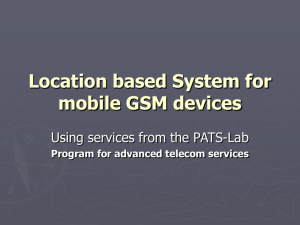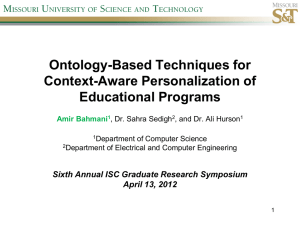Towards a Better Understanding of Context and Context-Awareness
advertisement
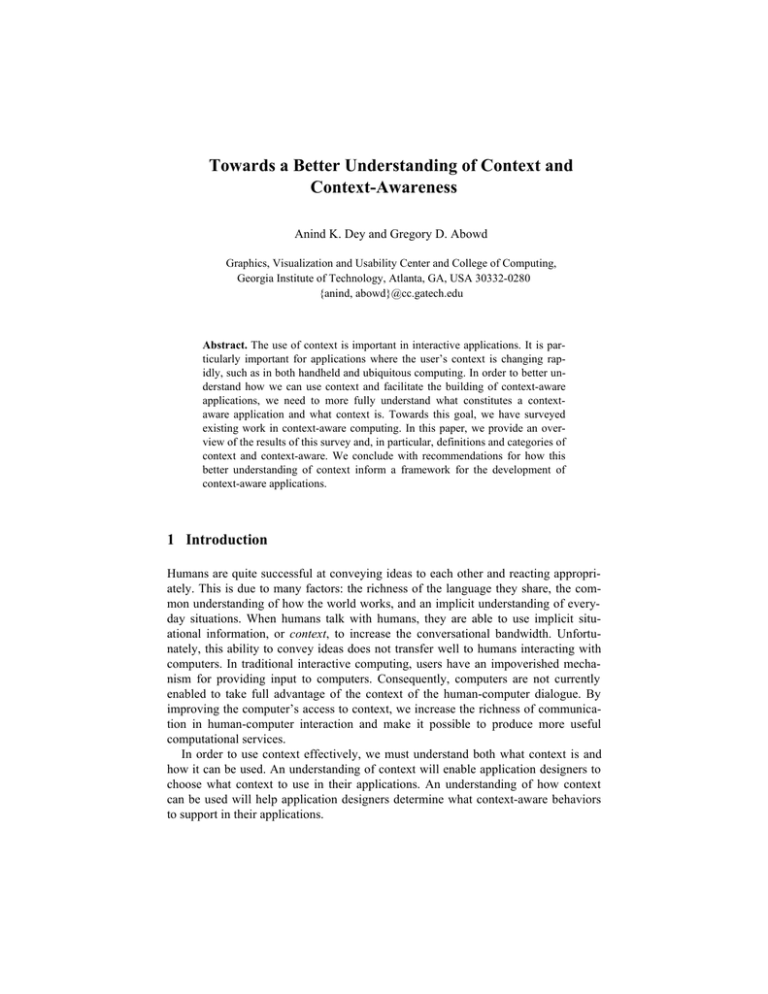
Towards a Better Understanding of Context and
Context-Awareness
Anind K. Dey and Gregory D. Abowd
Graphics, Visualization and Usability Center and College of Computing,
Georgia Institute of Technology, Atlanta, GA, USA 30332-0280
{anind, abowd}@cc.gatech.edu
Abstract. The use of context is important in interactive applications. It is particularly important for applications where the user’s context is changing rapidly, such as in both handheld and ubiquitous computing. In order to better understand how we can use context and facilitate the building of context-aware
applications, we need to more fully understand what constitutes a contextaware application and what context is. Towards this goal, we have surveyed
existing work in context-aware computing. In this paper, we provide an overview of the results of this survey and, in particular, definitions and categories of
context and context-aware. We conclude with recommendations for how this
better understanding of context inform a framework for the development of
context-aware applications.
1 Introduction
Humans are quite successful at conveying ideas to each other and reacting appropriately. This is due to many factors: the richness of the language they share, the common understanding of how the world works, and an implicit understanding of everyday situations. When humans talk with humans, they are able to use implicit situational information, or context, to increase the conversational bandwidth. Unfortunately, this ability to convey ideas does not transfer well to humans interacting with
computers. In traditional interactive computing, users have an impoverished mechanism for providing input to computers. Consequently, computers are not currently
enabled to take full advantage of the context of the human-computer dialogue. By
improving the computer’s access to context, we increase the richness of communication in human-computer interaction and make it possible to produce more useful
computational services.
In order to use context effectively, we must understand both what context is and
how it can be used. An understanding of context will enable application designers to
choose what context to use in their applications. An understanding of how context
can be used will help application designers determine what context-aware behaviors
to support in their applications.
How do we as applications developers provide the context to the computers, or
make those applications aware and responsive to the full context of human-computer
interaction? We could require users explicitly to express all information relevant to a
given situation. However, the goal of context-aware computing should be to make
interacting with computers easier. Forcing users consciously to increase the amount
of information is more difficult for them and tedious. Furthermore, it is likely that
most users will not know which information is potentially relevant and, therefore, will
not know what information to announce. Instead, our approach to context-aware
application development is to collect contextual information through automated
means, make it easily available to a computer’s run-time environment, and let the
application designer decide what information is relevant and how to deal with it. This
is the better approach, for it removes the need for users to make all information explicit and it puts the decisions about what is relevant into the designer’s hands. The
application designer should have spent considerably more time analyzing the situations under which the application will be executed and can more appropriately determine what information is relevant and how to react to it.
How is this discussion of context relevant to handheld and ubiquitous computing?
In these settings, the user has increased freedom of mobility. The increase in mobility
creates situations where the user’s context, such as the location of a user and the people and objects around her, is more dynamic. Both handheld and ubiquitous computing have given users the expectation that they can access information services whenever and wherever they are. With a wide range of possible user situations, we need to
have a way for the services to adapt appropriately, in order to best support the human–computer interaction.
Realizing the need for context is only the first step toward using it effectively.
Most researchers have a general idea about what context is and use that general idea
to guide their use of it. However, a vague notion of context is not sufficient; in order
to effectively use context, we must attain a better understanding of what context is.
In this paper, we will review previous attempts to define and provide a characterization of context and context-aware computing, and present our own definition and
characterization. We then discuss how this increased understanding informs the development of a shared infrastructure for context-sensing and context-aware application development.
2 What is Context?
To develop a specific definition that can be used prescriptively in the context-aware
computing field, we will look at how researchers have attempted to define context in
their own work. While most people tacitly understand what context is, they find it
hard to elucidate. Previous definitions of context are done by enumeration of examples or by choosing synonyms for context.
2.1 Previous Definitions of Context
In the work that first introduces the term ‘context-aware,’ Schilit and Theimer [26]
refer to context as location, identities of nearby people and objects, and changes to
those objects. In a similar definition, Brown et al. [3] define context as location,
identities of the people around the user, the time of day, season, temperature, etc.
Ryan et al. [22] define context as the user’s location, environment, identity and time.
Dey [8] enumerates context as the user’s emotional state, focus of attention, location
and orientation, date and time, objects, and people in the user’s environment. These
definitions that define context by example are difficult to apply. When we want to
determine whether a type of information not listed in the definition is context or not,
it is not clear how we can use the definition to solve the dilemma.
Other definitions have simply provided synonyms for context; for example, referring to context as the environment or situation. Some consider context to be the user’s
environment, while others consider it to be the application’s environment. Brown [4]
defined context to be the elements of the user’s environment that the user’s computer
knows about. Franklin & Flaschbart [14] see it as the situation of the user. Ward et al.
[27] view context as the state of the application’s surroundings and Rodden et al. [20]
define it to be the application’s setting. Hull et al. [15] included the entire environment by defining context to be aspects of the current situation. As with the definitions
by example, definitions that simply use synonyms for context are extremely difficult
to apply in practice.
The definitions by Schilit et al. [25], Dey et al. [9] and Pascoe [17] are closest in
spirit to the operational definition we desire. Schilit et al. claim that the important
aspects of context are: where you are, who you are with, and what resources are
nearby. They define context to be the constantly changing execution environment.
They include the following pieces of the environment:
• Computing environment available processors, devices accessible for user
input and display, network capacity, connectivity, and costs of computing
• User environment location, collection of nearby people, and social situation
• Physical environment lighting and noise level
Dey et al. define context to be the user's physical, social, emotional or informational state. Finally, Pascoe defines context to be the subset of physical and conceptual states of interest to a particular entity. These definitions are too specific. Context
is all about the whole situation relevant to an application and its set of users. We cannot enumerate which aspects of all situations are important, as this will change from
situation to situation. In some cases, the physical environment may be important,
while in others it may be completely immaterial. For this reason, we could not use the
definitions provided by Schilit et al., Dey et al., or Pascoe.
2.2 Our Definition of Context
Context is any information that can be used to characterize the
situation of an entity. An entity is a person, place, or object that is
considered relevant to the interaction between a user and an application, including the user and applications themselves.
This definition makes it easier for an application developer to enumerate the context for a given application scenario. If a piece of information can be used to characterize the situation of a participant in an interaction, then that information is context.
Take the task of using a spreadsheet to add a list of weights as an example. The entities in this example are the user and the application. We will look at two pieces of
information – presence of other people and location – and use the definition to determine whether either one is context. The presence of other people in the room does not
affect the user or the application for the purpose of this task. Therefore, it is not context. The user’s location, however, can be used to characterize the user’s situation. If
the user is located in the United States, the sum of the weights will be presented in
terms of pounds and ounces. If the user is located in Canada, the sum of the weights
will be presented in terms of kilograms. Therefore, the user’s location is context because it can be used to characterize the user’s situation.
A general assumption is that context consists only of implicit information, but this
is a troublesome distinction. Our definition allows context to be either explicitly or
implicitly indicated by the user. For example, whether a user’s identity is detected
implicitly using vision or explicitly via a login dialogue, the user’s identity is still
context. Researchers have focussed on implicit information because there is much
unexplored promise in leveraging off implicit information pertaining to the human–
computer interaction.
2.3 Categories of Context
A categorization of context types will help application designers uncover the most
likely pieces of context that will be useful in their applications. Previous definitions
of context seed our development of context types. Ryan et al. [22] suggest context
types of location, environment, identity and time. Schilit et al. [25] list the important
aspects of context as where you are, who you are with and what resources are nearby.
Context-aware applications look at the who’s, where’s, when’s and what’s (that is,
what the user is doing) of entities and use this information to determine why the
situation is occurring. An application doesn’t actually determine why a situation is
occurring, but the designer of the application does. The designer uses incoming context to determine why a situation is occurring and uses this to encode some action in
the application. For example, in a context-aware tour guide, a user carrying a handheld computer approaches some interesting site resulting in information relevant to
the site being displayed on the computer. In this situation, the designer has encoded
the understanding that when a user approaches a particular site (the ‘incoming context’), it means that the user is interested in the site (the ‘why’) and the application
should display some relevant information (the ‘action’).
There are certain types of context that are, in practice, more important than others.
These are location, identity, activity and time. The only difference between this list
and the definition of context provided by Ryan et al. is the use of ‘activity’ rather
than ‘environment’. Environment is a synonym for context and does not add to our
investigation of context. Activity, on the other hand, answers a fundamental question
of what is occurring in the situation. The categories provided by Schilit et al. (where
you are, who you are with, and what objects are around you) only include location
and identity information. To characterize a situation, we also need activity and time
information.
Location, identity, time, and activity are the primary context types for characterizing the situation of a particular entity. These context types not only answer the
questions of who, what, when, and where, but also act as indices into other sources of
contextual information. For example, given a person’s identity, we can acquire many
pieces of related information such as phone numbers, addresses, email addresses,
birthdate, list of friends, relationships to other people in the environment, etc. With an
entity’s location, we can determine what other objects or people are near the entity
and what activity is occurring near the entity. From these examples, it should be evident that the primary pieces of context for one entity can be used as indices to find
secondary context (e.g., the email address) for that same entity as well as primary
context for other related entities (e.g., other people in the same location).
In this initial categorization, we have a simple two-tiered system. The four primary
pieces of context already identified are on the first level. All the other types of context
are on the second level. The secondary pieces of context share a common characteristic: they can be indexed by primary context because they are attributes of the entity
with primary context. For example, a user’s phone number is a piece of secondary
context and it can be obtained by using the user’s identity as an index into an information space like a phone directory. There are some situations in which multiple
pieces of primary context are required to index into an information space. For example, the forecasted weather is context in an outdoor tour guide that uses the information to schedule a tour for users. To obtain the forecasted weather, both the location
for the forecast and the date of the desired forecast are required.
This characterization helps designers choose context to use in their applications,
structure the context they use, and search out other relevant context. The four primary
pieces of context indicate the types of information necessary for characterizing a
situation and their use as indices provide a way for the context to be used and organized. Now that we have given a definition of context, we can begin to think about
how to use context. In the next section, we define context-aware and provide a characterization of context-aware application features.
3 Defining Context-Aware Computing
Context-aware computing was first discussed by Schilit and Theimer [26] in 1994 to
be software that “adapts according to its location of use, the collection of nearby
people and objects, as well as changes to those objects over time.” However, it is
commonly agreed that the first research investigation of context-aware computing
was the Olivetti Active Badge [28] work in 1992. Since then, there have been numer-
ous attempts to define context-aware computing, and these all inform our own definition.
3.1 Previous Definitions of Context-Aware
The first definition of context-aware applications given by Schilit and Theimer [26]
restricted the definition from applications that are simply informed about context to
applications that adapt themselves to context.
Context-aware has become somewhat synonymous with other terms: adaptive [2],
reactive [6], responsive [12], situated [15], context-sensitive [19] and environmentdirected [13]. Previous definitions of context-aware computing fall into two categories: using context and adapting to context.
We will first discuss the more general case of using context. Hull et al. [15] and
Pascoe et al. [17,18,22] define context-aware computing to be the ability of computing devices to detect and sense, interpret and respond to aspects of a user's local environment and the computing devices themselves. Dey [8] limits context-awareness to
the human–computer interface, as opposed to the underlying application. Dey et al.
[9] begin to introduce the notion of adaptation by defining context-awareness to be
work leading to the automation of a software system based on knowledge of the
user’s context. Salber et al [23] define context-aware to be the ability to provide
maximum flexibility of a computational service based on real-time sensing of context.
The following definitions are in the more specific “adapting to context” category.
Many researchers [25,27,16,3,7,10,1] define context-aware applications to be applications that dynamically change or adapt their behavior based on the context of the
application and the user. More specifically, Ryan [21] defines context-aware applications to be applications that monitor input from environmental sensors and allow
users to select from a range of physical and logical contexts according to their current
interests or activities. This definition is more restrictive than the previous one by
identifying the method in which applications acts upon context. Brown [5] defines
context-aware applications as applications that automatically provide information
and/or take actions according to the user’s present context as detected by sensors. He
also takes a narrow view of context-aware computing by stating that these actions can
take the form of presenting information to the user, executing a program according to
context, or configuring a graphical layout according to context. Finally, Fickas et al
[13] define environment-directed (practical synonym for context-aware) applications
to be applications that monitor changes in the environment and adapt their operation
according to predefined or user-defined guidelines.
3.2 Our Definition of Context-Aware
A system is context-aware if it uses context to provide relevant information and/or services to the user, where relevancy depends on
the user’s task.
We have chosen a more general definition of context-aware computing. The definitions in the more specific “adapting to context” category require that an application’s behavior be modified for it to be considered context-aware. When we try to
apply these definitions to established context-aware applications, we find that they do
not fit. For example, an application that simply displays the context of the user’s
environment to the user is not modifying its behavior, but it is context-aware. If we
use the less general definitions, these applications would not be classified as contextaware. We, therefore, chose a more general definition that does not exclude existing
context-aware applications.
We will compare our definition to the general definitions provided above. Our
definition is more general than the one provided by Hull et al. [15] and Pascoe et al.
[17,18,22]. They require their context-aware systems to detect, interpret and respond
to context. We only require the response to context, allowing the detection and interpretation to be performed by other computing entities. It differs from the other general definitions given above by focussing on the user, not limiting awareness to just
the application interface [8], not requiring applications to perform services automatically [9], and not requiring real-time acquisition of context [23].
Categorization of Features for Context-Aware Applications In a further attempt to
help define the field of context-aware applications, we will present a categorization
for features of context-aware applications. There have been two attempts to develop
such a taxonomy. The first was by Schilit et al. [25] and had 2 orthogonal
dimensions: whether the task is to get information or to execute a command and
whether the task is executed manually or automatically. Applications that retrieve
information for the user manually based on available context are classified as
proximate selection applications. It is an interaction technique where a list of objects
(printers) or places (offices) is presented, where items relevant to the user’s context
are emphasized or made easier to choose. Applications that retrieve information for
the user automatically based on available context are classified as automatic
contextual reconfiguration. It is a system-level technique that creates an automatic
binding to an available resource based on current context. Applications that execute
commands for the user manually based on available context are classified as
contextual command applications. They are executable services made available due to
the user’s context or whose execution is modified based on the user’s context.
Finally, applications that execute commands for the user automatically based on
available context use context-triggered actions. They are services that are executed
automatically when the right combination of context exists, and are based on simple
if-then rules.
More recently, Pascoe [17] proposed a taxonomy of context-aware features. There
is considerable overlap between the two taxonomies but some crucial differences as
well. Pascoe [17] developed a taxonomy aimed at identifying the core features of
context-awareness, as opposed to the previous taxonomy, which identified classes of
context-aware applications. In reality, the following features of context-awareness
map well to the classes of applications in the Schilit taxonomy. The first feature is
contextual sensing and is the ability to detect contextual information and present it to
the user, augmenting the user’s sensory system. This is similar to proximate selection,
except in this case, the user does not necessarily need to select one of the context
items for more information (i.e. the context may be the information required). The
next feature is contextual adaptation and is the ability to execute or modify a service
automatically based on the current context. This maps directly to Schilit’s contexttriggered actions. The third feature, contextual resource discovery, allows contextaware applications to locate and exploit resources and services that are relevant to the
user’s context. This maps directly to automatic contextual reconfiguration. The final
feature, contextual augmentation, is the ability to associate digital data with the user’s
context. A user can view the data when he is in that associated context. For example,
a user can create a virtual note providing details about a broken television and attach
the note to the television. When another user is close to the television or attempts to
use it, he will see the virtual note left previously.
Pascoe and Schilit both list the ability to exploit resources relevant to the user’s
context, the ability to execute a command automatically based on the user’s context
and the ability to display relevant information to the user. Pascoe goes further in
terms of displaying relevant information to the user by including the display of context, and not just information that requires further selection (e.g. showing the user’s
location vs. showing a list of printers and allowing the user to choose one). Pascoe’s
taxonomy has a category not found in Schilit’s taxonomy: contextual augmentation,
or the ability to associate digital data with the user’s context. Finally, Pascoe’s taxonomy does not support the presentation of commands relevant to a user’s context. This
presentation is called contextual commands in Schilit’s taxonomy.
Our proposed categorization combines the ideas from these two taxonomies and
takes into account the three major differences. Similar to Pascoe’s taxonomy, it is a
list of the context-aware features that context-aware applications may support. There
are three categories:
1) presentation of information and services to a user;
2) automatic execution of a service; and
3) tagging of context to information for later retrieval
Presentation is a combination of Schilit’s proximate selection and contextual
commands. To this, we have added Pascoe’s notion of presenting context (as a form
of information) to the user. Automatic execution is the same as Schilit’s contexttriggered actions and Pascoe’s contextual adaptation. Tagging is the same as Pascoe’s
contextual augmentation.
We introduce two important distinguishing characteristics: the decision not to differentiate between information and services, and the removal of the exploitation of
local resources as a feature. We do not to use Schilit’s dimension of information vs.
services to distinguish between our categories. In most cases, it is too difficult to
distinguish between a presentation of information and a presentation of services. For
example, Schilit writes that a list of printers ordered by proximity to the user is an
example of providing information to the user. But, whether that list is a list of information or a list of services depends on how the user actually uses that information.
For example, if the user just looks at the list of printers to become familiar with the
names of the printers nearby, she is using the list as information. However, if the user
chooses a printer from that list to print to, she is using the list as a set of services.
Rather than try to assume the user’s state of mind, we chose to treat information and
services in a similar fashion.
We chose not to use the exploitation of local resources, or resource discovery, as a
context-aware feature. This feature is called automatic contextual reconfiguration in
Schilit’s taxonomy and contextual resource discovery in Pascoe’s taxonomy. We do
not see this as a separate feature category, but rather as part of our first two categories. Resource discovery is the ability to locate new services according to the user’s
context. This ability is really no different than choosing services based on context.
We can illustrate our point by reusing the list of printers example. When a user enters
an office, their location changes and the list of nearby printers changes. The list
changes by having printers added, removed, or being reordered (by proximity, for
example). Is this an instance of resource exploitation or simply a presentation of information and services? Rather than giving resource discovery its own category, we
split it into two of our existing categories: presenting information and services to a
user and automatically executing a service. When an application presents information
to a user, it falls into the first category, and when it automatically executes a service
for the user, it falls into the second category.
Cataloguing previous context-aware work We applied our categories of context
and context-aware features to the applications discussed in the related research we
have presented. The results are in Table 1 below. Under the context type heading, we
present Activity, Identity, Location, and Time. Under the context-aware heading, we
present our 3 context-aware features, Presentation, automatic Execution, and
Tagging.
Table 1. Application of context and context-aware categories
System Name
System Description
Classroom 2000 [1]
Cyberguide [1]
Teleport [2]
Stick-e Documents [3,4,5]
Capture of a classroom lecture
Tour guide
Teleporting
Tour guide
Paging and reminders
Intelligent control of audiovisuals
Tour guide
Automatic integration of user services
Conference capture and tour guide
Office environment control
Network maintenance
Fieldwork data collection
Virtual post-it notes
In/Out Board
Capture of serendipitous meetings
Call forwarding
Reactive Room [6]
GUIDE [7]
CyberDesk [8,9,10]
Conference Assistant [11]
Responsive Office [12]
NETMAN [13,16]
Fieldwork [17,18,22]
Augment-able Reality [19]
Context Toolkit [24]
Active Badge [28]
Context Type
A I L T
X X
X X
X X X
X X X
X X
X X X
X
X
X X X X
X X
X
X X
X
X X X
X X X
X X
Context-Aware
P
E
T
X
X
X
X
X
X
X
X
X
X
X
X
X
X
X
X
X
X
X
X
X
X
X
X
From this table, we see that while many applications make use of both location and
identity context, few make use of activity context. We also note that many applications use the presentation feature, but fewer use the execution and tagging features.
This table indicates that there are areas which need addressing in the space of contextaware applications.
4
Impact on Context-Aware Application Development
In the previous sections, we presented definitions and categories for both context and
context-aware. We have applied these definitions and categories to our own research
and they have helped to inform the design of an architecture to support context-aware
computing and the design of context-aware applications [11].
Our architecture1 is built on the concept of enabling applications to obtain the
context they require without them having to worry about how the context was sensed.
In previous work, we presented the context widget [24], an abstraction that implements this concept. A context widget is responsible for acquiring a certain type of
context information and it makes that information available to applications in a generic manner, regardless of how it is actually sensed.
Our definition of context provided another important abstraction. We defined it as
information used to characterized the situation of an entity. If we think of a context
widget as being responsible for a single piece of information, we need an abstraction
to represent an entity. This abstraction, which we call a context server in our architecture, is responsible for the entire context about a single entity. When designers
think about context and interactions, it is natural for them to think in terms of entities,
and that makes a context server the correct abstraction to use for building applications. Context servers gather the context about an entity (e.g., a person) from the
available context widgets, behaving as a proxy to the context for applications.
Context types inform us both on the variety of context widgets needed and on the
features needed to be supported by context servers. At the very minimum, our architecture needs to contain context widgets that collect information on our four primary
context types: activity, identity, location, and time. Our context servers also need to
support these primary types. Primary context types could be used to both index into
more information about a particular entity (secondary context) and index into other
entities. To allow applications to leverage this first feature, context servers need to
support the retrieving of secondary context information indexed by primary context
types. For the second feature, context servers must provide facilities to each other to
allow comparison on the primary context types. This will allow an entity to create
dynamic relationships with and locate other entities that share all or part of its context, for example, to identify all the people meeting in the same room.
While our definition of context-aware has not directly impacted our architecture, it
has provided us with a way to conclude whether an application is context-aware or
not. This has been useful in determining what types of applications our architecture
1
For more information on the architecture, see http://www.cc.gatech.edu/fce/contexttoolkit
needs to support, and therefore what features it must have. Our categorization of
context-aware features provides us with two main benefits. The first is that it further
specifies the types of applications the architecture must provide support for. The
second benefit is that it shows us the types of features that we should be thinking
about when building our own context-aware applications.
5 Conclusions
In handheld and ubiquitous computing, a user’s context is very dynamic. When using
applications in these settings, a user has much to gain by the effective use of implicitly sensed context. It allows an application’s behavior to be customized to the user’s
current situation. To promote a more effective use of context, we have provided definitions and categorizations of context and context-aware computing.
We have defined context to be any information that can be used to characterize the
situation of an entity, where an entity can be a person, place, or object. In contextaware computing, these entities are anything relevant to the interaction between the
user and application, including the user and the application. We provided an initial set
of primary context types —location, identity, time and activity. Context-aware applications use context to provide task-relevant information and/or services to a user. We
defined categories of context-aware applications —the presentation of information
and services, automatic execution of services, and tagging information with context.
These definitions and categorizations will assist researchers understand the
boundaries of context-aware computing, and help application designers select context
to use, structure context in applications, and decide what context-aware features to
implement. In an effort to substantiate this claim, we have begun work on a framework [24] to support the building of context-aware applications. The definitions and
categorizations presented in this paper have both influenced the design of the framework [11] and the design of context-aware applications we have built. Through the
use of this framework and the development of more applications, we hope to further
increase our understanding of context and context-awareness.
References
1.
2.
3.
4.
5.
6.
Abowd, G.D., Dey, A.K., Orr, R., Brotherton, J. Context-Awareness in Wearable and Ubiquitous
st
Computing. 1 International Symposium on Wearable Computers (1997) 179-180
Brown, M. Supporting User Mobility. International Federation for Information Processing (1996)
Brown, P.J., Bovey, J.D. Chen, X. Context-Aware Applications: From the Laboratory to the Marketplace. IEEE Personal Communications, 4(5) (1997) 58-64
Brown, P.J. The Stick-e Document: a Framework for Creating Context-Aware Applications. Electronic Publishing ’96 (1996) 259-272
Brown, P.J. Triggering Information by Context. Personal Technologies, 2(1) (1998) 1-9
Cooperstock, J., Tanikoshi, K., Beirne, G., Narine, T., Buxton, W. Evolution of a Reactive Environment CHI ’95 (1995) 170-177
7.
8.
9.
10.
11.
12.
13.
14.
15.
16.
17.
18.
19.
20.
21.
22.
23.
24.
25.
26.
27.
28.
Davies, N., Mitchell, K., Cheverst, K. Blair, G. Developing a Context Sensitive Tourist Guide. 1 st
Workshop on Human Computer Interaction with Mobile Devices, GIST Technical Report G98-1
(1998)
Dey, A.K. Context-Aware Computing: The CyberDesk Project. AAAI 1998 Spring Symposium on
Intelligent Environments, Technical Report SS-98-02 (1998) 51-54
Dey, A.K., Abowd, G.D., Wood, A. CyberDesk: A Framework for Providing Self-Integrating Context-Aware Services. Knowledge-Based Systems, 11 (1999) 3-13
Dey, A.K., Abowd, G.D. CyberDesk: The Use of Perception in Context-Aware Computing. 1st
Workshop on Perceptual User Interfaces (1997) 26-27
Dey, A.K., Salber, D., Futakawa, M., Abowd, G.D. An Architecture to Support Context-Aware
Computing. Submitted to UIST ‘99
Elrod, S., Hall, G., Costanza, R., Dixon, M., des Rivieres, J. Responsive Office Environments.
CACM 36(7) (1993) 84-85
Fickas, S., Korteum, G., Segall, Z. Software Organization for Dynamic and Adaptable Wearable
Systems. 1st International Symposium on Wearable Computers (1997) 56-63
Franklin, D., Flaschbart, J. All Gadget and No Representation Makes Jack a Dull Environment.
AAAI 1998 Spring Symposium on Intelligent Environments, Technical Report SS-98-02 (1998)
155-160
Hull, R., Neaves, P., Bedford-Roberts, J. Towards Situated Computing. 1st International Symposium
on Wearable Computers (1997) 146-153
Korteum, G., Segall, Z., Bauer, M. Context-Aware, Adaptive Wearable Computers as Remote
Interfaces to “Intelligent” Environments. 2nd International Symposium on Wearable Computers
(1998) 58-65
Pascoe, J. Adding Generic Contextual Capabilities to Wearable Computers. 2nd International Symposium on Wearable Computers (1998) 92-99
Pascoe, J., Ryan, N.S., Morse, D.R. Human-Computer-Giraffe Interaction – HCI in the Field. Workshop on Human Computer Interaction with Mobile Devices. (1998)
Rekimoto, J., Ayatsuka, Y., Hayashi, K. Augment-able Reality: Situated Communication through
Physical and Digital Spaces. 2nd International Symposium on Wearable Computers (1998) 68-75
Rodden, T., Cheverst, K., Davies, K. Dix, A.. Exploiting Context in HCI Design for Mobile Systems. Workshop on Human Computer Interaction with Mobile Devices (1998)
Ryan, N. Mobile Computing in a Fieldwork Environment: Metadata Elements. Project working
document, version 0.2 (1997)
Ryan, N., Pascoe, J., Morse, D. Enhanced Reality Fieldwork: the Context-Aware Archaeological
Assistant. Gaffney,V., van Leusen, M., Exxon, S. (eds.) Computer Applications in Archaeology
(1997)
Salber, D., Dey, A.K., Abowd, G.D. Ubiquitous Computing: Defining an HCI Research Agenda for
an Emerging Interaction Paradigm. Georgia Tech GVU Technical Report GIT-GVU-98-01 (1998)
Salber, D., Dey, A.K., Abowd, G.D. The Context Toolkit: Aiding the Development of ContextEnabled Applications. To appear in CHI’99 (1999)
Schilit, B., Adams, N. Want, R. Context-Aware Computing Applications. 1st International Workshop
on Mobile Computing Systems and Applications. (1994) 85-90
Schilit, B., Theimer, M. Disseminating Active Map Information to Mobile Hosts. IEEE Network,
8(5) (1994) 22-32
Ward, A., Jones, A., Hopper, A. A New Location Technique for the Active Office. IEEE Personal
Communications 4(5) (1997) 42-47
Want, R., Hopper, A., Falcao, V., Gibbons, J. The Active Badge Location System. ACM Transactions on Information Systems 10(1) (1992) 91-102
